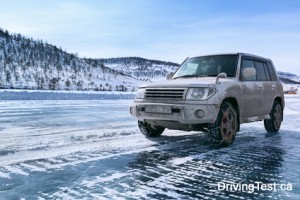1. Before you leave, take a few minutes to clear your vehicle of accumulated ice or snow. Make sure that your windshield and other windows are fully defrosted.
2. Start off slowly so you can get a feel for the condition of the road, and properly judge your steering and braking capabilities.
3. As you travel, adjust your speed to any changes in the road conditions, to ensure you have enough time to slow down or stop safely.
4. When turning or attempting to stop, start slowing down three times sooner than you would when roads are clear and dry.
5. To maintain control of your vehicle, steer smoothly and avoid changing lanes abruptly.
6. Stay aware of the road ahead at all times so that you won’t have to accelerate or apply your brakes too sharply.
7. Watch further ahead than you would when driving on a bare road, so you can react to any dangers quickly.
8. If you need to apply your brakes, do it gently so they don’t lock up. If you feel your wheels starting to lock, ease off the brake pedal gradually.
9. Know what type of brakes you have, and how best to use them under icy conditions. With an ABS braking system, you should apply steady pressure. If you don’t have ABS brakes, you should pump the brake pedal gently.
10. If you feel you’re starting to skid, slowly ease your foot off the gas pedal, but don’t attempt to apply the brakes. As your tires start to gain traction, slowly turn the steering wheel in the direction that you want the front wheels to go.
11. Allow eight to ten-second gap between you and the vehicle ahead to help prevent a rear-end collision. Maintain three times the distance that you normally would when driving on clear, dry roads.

12. Turn your lights on to ensure your vehicle is easily seen by other drivers.
13. To improve your own visibility, use your wipers and defrosters to keep your windows clear.
14. Clean your lights periodically to remove any build-up of ice and salt spray.
15. Make sure that your tire pressure is correct, so they can grip the road properly.
16. To improve your traction, use a lower gear on hills and turns.
17. Turn off your cruise control so that you’re in complete control of your vehicle.
18. Drop your speed when you approach bridges, overpasses, tunnels and any areas of the roadway that are shaded. Even if the air temperature is above zero degree, these areas may still be slick.
19. When you encounter a plow or sanding truck, don’t attempt to pass. The driver’s reduced visibility makes it risky, and the road ahead is probably in worse condition.
20. Don’t be lulled into a false sense of security just because you’re driving a four-wheel or all-wheel drive vehicle. They don’t offer any additional stopping or steering benefits on icy roads.
Icy roads pose a danger to even the most experienced drivers. Reducing your speed and exercising caution can lower your risk of becoming an accident statistic and may even save your life.